When an employee is injured, it is extremely important for the leaders of a business to respond as fast as possible. This response includes dealing with the medical issues of the injured employee as well as filing the proper workers’ compensation paperwork. Taking care of both the human and the business side of an incident involving an injured employee will go a long way towards the success of a business. Here are four ways to respond when your business experiences an injured employee.

Read and Follow OSHA’s recommendations
The Occupational Safety and Health Administration (OSHA) sets the standards employers are expected to follow regarding workplace safety. Employers should also know what to do when safety measures fail and an employee is injured at work because the more prepared a business is, the less likely an injury at work will prove costly. With this in mind, there are four main steps that can help business owners plan ahead.

Plan ahead and Prepare
The first step in protecting employees is being preparation. Workplace accidents happen, but they happen less frequently and are less severe when the organization is prepared. A quick response to any incident can not only reduce the severity of the injury, but also the cost of the injury. Developing a response plan should be a part of your business leaders monthly and yearly routine. These plans, if executed properly, can minimize common hazards and prevent injuries before they occur. This process should include:
- Creating response plans
- Training employees and supervisors on those response plans
- Stocking first-aid supplies and making sure they are easily accessible
- Maintaining emergency contacts in a file where all employees have access
- Assigning a safety officer or a safety committee to assess potential risks
Respond immediately after injury
When an injury occurs to one of your employees, the first thing anyone involved in your agency should do is take care of the immediate needs of the injured employee. It is the right thing to do from a human aspect, but also it is the right thing to do from a business stand point. Taking care of the injured employee requires you to first get the injured employee to a safe place, assess the severity of the injury and how best to proceed, help the injured feel better, and gather the necessary information about how the injury occurred (When, Where, How, etc). Having your own internal reporting process is important because after this information is gathered, the manager can use this information to file a first report of injury form with your insurance carrier. Shortly after an injury occurs, the difference between preparedness and panic can be huge. Preparation is the best way to make sure your employees keep a cool head after a worker is injured on the job. This will minimize the severity of the injury and protect the business from additional liability.
Paperwork and Communication are Crucial
When a business experiences an injured employee, the manager on duty should first and foremost take care of the injured employee, but at the same time they need to document as much as possible. This will aide the injured employee in getting timely medical coverage through the workers compensation system. It is also in the best interest of the employer to maintain open communication with both the insurance carrier, the doctor, and the injured employee. This will expedite the claims process and allow the employee to get the benefits they deserve fast. A return to work program should be in place for getting injured employees back on the job, even in a limited capacity, faster and it will make the injured employee more likely to return to full time permanent work.
Prepare for a Lawsuit
sometimes, when an employee is hurt on the job they decide to sue the employer. Even when an injured employee sues, it is wise to continue to keep the lines of communication open and help the employee get the workers compensation benefits they deserve. It will not look good in the eyes of a judge or a jury if the business shuts off communication in the face of a lawsuit.
The lawsuit does not have to be founded and damages do not have to be awarded for it to amount to an enormous cost for a business. It is wise to share all relevant information, including documentation, with attorneys and claims adjusters throughout the legal process. This is because the longer a litigated claim lasts, the more expensive it tends to become. It is also wise to remember that settling a claim early can prevent a much costlier, drawn-out lawsuit. Your insurance carrier should be able to give you advice throughout this process. Do not let pride get in the way. Most of the time it is best to settle and get back to business no mater what the facts of the lawsuit entail.
